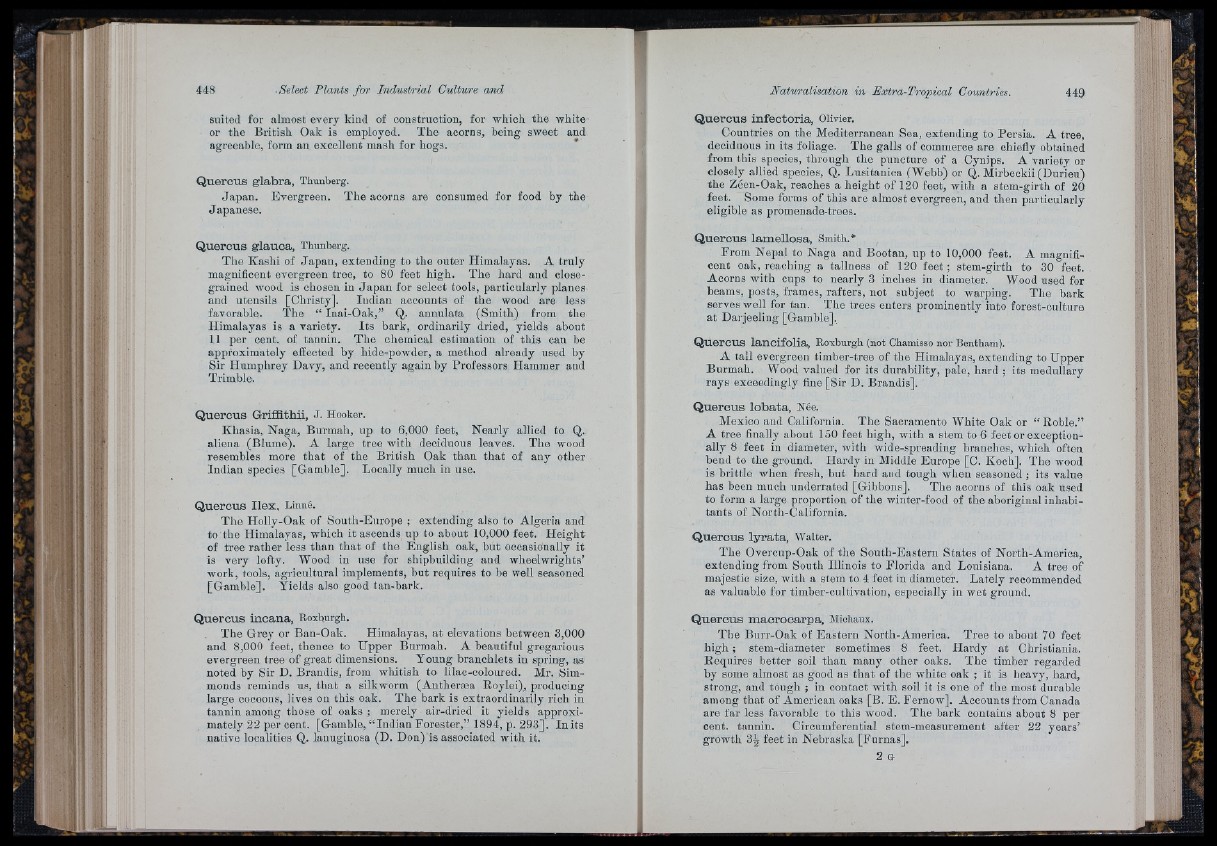
suited for almost every kind of construction, for which the white
or the British Oak is employed. The acorns, being sweet and
agreeable, form an e.xcellent mash for hogs.
Quercus glabra, Thunberg.
Japan. Evergreen. The acorns are consumed for food by the
Japanese.
Quercus glauca, Thunberg.
Tlie Kashi of Jap an , extending to the outer Himalayas. A truly
magnificent evergreen tree, to 80 feet high. The hard and close-
grained wood is chosen in Jap an for select tools, particularly planes
and utensils [Christy]. Indian accounts of the wood are less
favorable. The “ Inai-Oak,” Q. annulata (Smith) from the
Himalayas is a variety. Its bark, ordinarily dried, yields about
11 per cent, of tannin. The chemical estimation of this can be
approximately effected by hide-powder, a method already used by
Sir Humphrey Davy, and recently again by Professors Hammer and
Trimble.
Quercus Grifflthii, J. Hooker.
Khasia, Naga, Burmah, up to 6,000 feet. Nearly allied to Q.
aliéna (Blume). A large tree with deciduous leaves. The wood
resembles more th a t of the British Oak than th a t of any other
Indian species [Gamble]. Locally much in use.
Quercus Ilex, Linné.
The Holly-Oak of South-Europe ; extending also to Algeria and
to the Himalayas, which it ascends up to about 10,000 feet. Height
of tree rather less than that of the English oak, but occasionally it
is very lofty. Wood in use for shipbuilding and wheelwrights’
work, tools, agricultural implements, but requires to be well seasoned
[Gamble]. Yields also good tan-bark.
Quercus incana, Roxburgh.
The Grey or Ban-Oak. Himalayas, a t elevations between 3,000
and 8,000 feet, thence to Upper Burmah. A beautiful gregarious
evergreen tree of great dimensions. Young branchlets in spring, as
noted by Sir D. Brandis, from whitish to lilac-coloured. Mr. Simmonds
reminds us, that a silkworm (Antheræa Roylei), producing
large cocoons, lives ou this oak. The bark is extraordinarily rich in
tannin among those of oaks ; merely air-dried it yields approximately
22 per cent. [Gamble, “ Indian Forester,” 1894, p. 293]. In its
native localities Q. lanuginosa (D. Don) is associated with it.
Quercus infectoria, Olivier.
Countries on the Mediterranean Sea, extending to Persia. A tree,
deciduous in its foliage. The galls of commerce are chiefly obtained
from this species, through tho puncture of a Cynips. A variety or
closely allied species, Q. Lusitanica (Webb) or Q. Mirbeckii (Durieu)
the Z6en-0ak, reaches a height of 120 feet, with a stem-girth of 20
feet. Some forms of this are almost evergreen, and then partioularly
eligible as promenade-trees.
Quercus lamellosa, Smith.*
From Nepal to Naga and Bootan, up to 10,000 feet. A magnificent
oak, reaching a tallness of 120 feet ; stem-girth to 30 feet.
Acorns with cups to nearly 3 inches iu diameter. Wood used for
beams, posts, frames, rafters, not subject to warping. The bark
serves well for tan. The trees enters prominently into forest-culture
at Darjeeling [Gamble],
Quercus lancifolia, Roxburgh (not Chamisso nor Bentham).
A tall evergreen timber-tree of tbe Himalayas, extending to Upper
Burmah. Wood valued for its durability, pale, hard ; its medullary
rays exceedingly fine [Sir D. Brandis].
Quercus lobata, Née.
Mexico and California. The Sacramento White Oak or “ Roble.”
A tree finally about 150 feet high, with a stem to 6 feet or exceptionally
8 feet in diameter, with wide-spreading branches, which often
bend to the ground. Hardy in Middle Europe [C. Koch]. The wood
is brittle when fresh, but hard aud tough when seasoned ; its valne
has been much underrated [Gibbons], The acorns of this oak used
to form a large proportion of the winter-food of the aboriginal inhabitants
of North-California.
Quercus lyrata, Walter.
The Overcup-Oak of the South-Eastern States of North-America,
extending from South Illinois to Florida and Louisiana. A tree of
majestic size, with a stem to 4 feet in diameter. Lately recommended
as valuable for timber-cultivation, especially in wet ground.
Quercus macrocarpa, Michaux.
Tbe Burr-Oak of Eastern North-America. Tree to about 70 feet
high ; stem-diameter sometimes 8 feet. Hardy at Christiania.
Eequires better soil than many other oaks. The timber regarded
by some almost as good as th a t of the white oak ; it is lieavy, hard,
strong, and tough ; in contact with soil it is one of the most durable
among that of American oaks [B. E. Fernow]. Accounts from Canada
are far less favorable to this wood. The bark contains about 8 per
cent, tannin. Circumferential stern-measurement after 22 years’
growth 3-^ feet in Nebraska [Furnas].
‘i. !